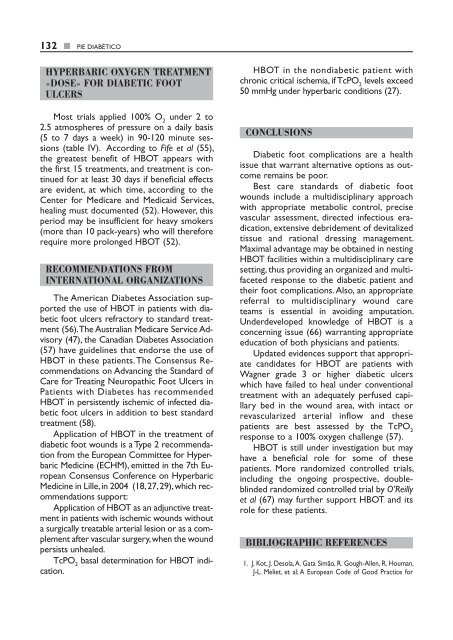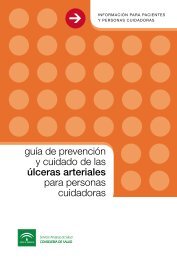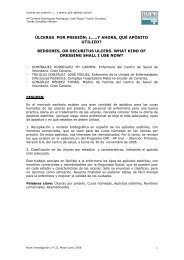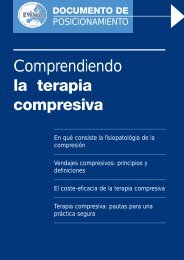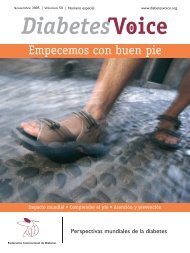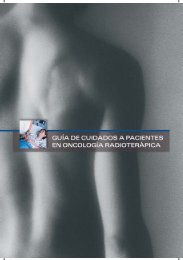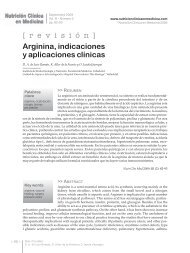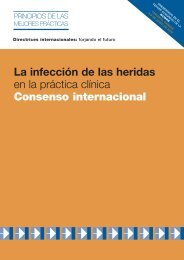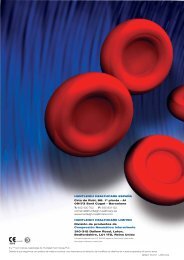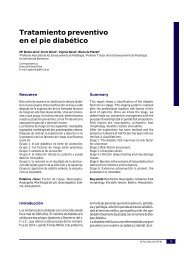Descargar - Úlceras.net
Descargar - Úlceras.net
Descargar - Úlceras.net
- No tags were found...
You also want an ePaper? Increase the reach of your titles
YUMPU automatically turns print PDFs into web optimized ePapers that Google loves.
132 ■ PIE DIABÉTICOHYPERBARIC OXYGEN TREATMENT«DOSE» FOR DIABETIC FOOTULCERSMost trials applied 100% O 2under 2 to2.5 atmospheres of pressure on a daily basis(5 to 7 days a week) in 90-120 minute sessions(table IV). According to Fife et al (55),the greatest benefit of HBOT appears withthe first 15 treatments, and treatment is continuedfor at least 30 days if beneficial effectsare evident, at which time, according to theCenter for Medicare and Medicaid Services,healing must documented (52). However, thisperiod may be insufficient for heavy smokers(more than 10 pack-years) who will thereforerequire more prolonged HBOT (52).RECOMMENDATIONS FROMINTERNATIONAL ORGANIZATIONSThe American Diabetes Association supportedthe use of HBOT in patients with diabeticfoot ulcers refractory to standard treatment(56). The Australian Medicare Service Advisory(47), the Canadian Diabetes Association(57) have guidelines that endorse the use ofHBOT in these patients. The Consensus Re -commendations on Advancing the Standard ofCare for Treating Neuropathic Foot Ulcers inPatients with Diabetes has recommendedHBOT in persistently ischemic of infected diabeticfoot ulcers in addition to best standardtreatment (58).Application of HBOT in the treatment ofdia betic foot wounds is a Type 2 recommendationfrom the European Committee for HyperbaricMedicine (ECHM), emitted in the 7th EuropeanConsensus Conference on HyperbaricMedicine in Lille, in 2004 (18, 27, 29), which recommendationssupport:Application of HBOT as an adjunctive treatmentin patients with ischemic wounds withouta surgically treatable arterial lesion or as a complementafter vascular surgery, when the woundpersists unhealed.TcPO 2basal determination for HBOT indication.HBOT in the nondiabetic patient withchronic critical ischemia, if TcPO 2levels exceed50 mmHg under hyperbaric conditions (27).CONCLUSIONSDiabetic foot complications are a healthissue that warrant alternative options as outcomeremains be poor.Best care standards of diabetic footwounds include a multidisciplinary approachwith appropriate metabolic control, precisevascular assessment, directed infectious era -dication, extensive debridement of devitalizedtissue and rational dressing management.Maximal advantage may be obtained in nestingHBOT facilities within a multidisciplinary caresetting, thus providing an organized and multifacetedresponse to the diabetic patient andtheir foot complications. Also, an appropriatereferral to multidisciplinary wound careteams is essential in avoiding amputation.Underdeveloped knowledge of HBOT is aconcerning issue (66) warranting appropriateeducation of both physicians and patients.Updated evidences support that appropriatecandidates for HBOT are patients withWagner grade 3 or higher diabetic ulcerswhich have failed to heal under conventionaltreatment with an adequately perfused capi -llary bed in the wound area, with intact orrevascularized arterial inflow and thesepatients are best assessed by the TcPO 2response to a 100% oxygen challenge (57).HBOT is still under investigation but mayhave a beneficial role for some of thesepatients. More randomized controlled trials,including the ongoing prospective, doubleblindedrandomized controlled trial by O’Reillyet al (67) may further support HBOT and itsrole for these patients.BIBLIOGRAPHIC REFERENCES1. J. Kot, J. Desola, A. Gata Simão, R. Gough-Allen, R. Houman,J-L. Meliet, et al; A European Code of Good Practice for


